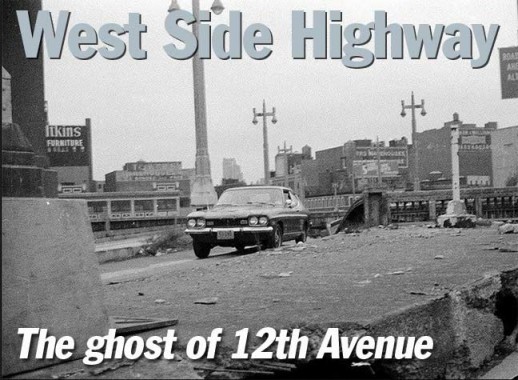New Yorkers of a Certain Age will remember the elevated West Side Highway — constructed on pillars over West Street and 12th Avenue in the 1930s, it connected downtown Manhattan with the Henry Hudson Parkway uptown. It was constructed in the early 1930s and was originally called the Julius Miller Highway for Manhattan’s borough preseident at the time it opened.
I remember it only from cab rides in the 1960s — it was a thrilling, though some would say, unnerving ride, as its original Belgian bricks remained un-blacktopped in most spots, and it took several sharp turns. Things were especially hairy during rainstorms. On and off ramps were located in the center of the roadway, necessitating expert driving skills to get on and off. The roadway suffered from deferred maintenance over the years, and In December 1973 a dump truck carrying 30 tons of asphalt crashed through the roadway along with a following automobile (killing neither driver). The WSH from the Battery to 18th Street was closed immediately, and other sections closed after that; the superstructure was finally torn down in 1989.
Before that, a proposal for a new expressway sunk under parkland along the same route, called Westway, was defeated because of environmental concerns; after 1989, the present surface roadway was settled on. In recent years bike paths and parkland have been added along the shore that had formerly been riverside docks.

West Side Highway in 1975. As the roadway remained in place, it became an unofficial version of what today we have in the High Line — pedestrians would come up (illegally), sit in the sun, walk around or play Frisbee, and motorists would abandon cars on the still-bricked roadway.

A view from just before the elevated highway closed. You can see the deterioration as chunks of concrete have worn away, revealing iron supporting rods.
The allowance of city management to allow roadways as well as other infrastructure like subways and bridges into a dangerous condition is one of the more perplexing episodes in NYC history. The deterioration lasted for decades, but it was especially felt in the 1970s and 1980s as the West Side Highway collapsed, the subway lanes on the Manhattan Bridge were closed off and on for over 20 years, and the Williamsburg Bridge was in danger of closure and replacement. Eventually billions of dollars were allocated for city infrastructure repairs that would have been cheaper if simple regular maintenance was maintained.
However, in NYC, its basic infrastructure is used by everyday people instead of Those Who Matter, and priorities are elsewhere much of the time.
One piece of original fencing and lighting remains: a closed off-ramp where the West Side Highway and Henry Hudson Parkway meet at West 72nd Street. I would imagine the piece is still there for purposes of structural integrity.
The lampposts date to the early 1930s when Machine Age design, a 180-degree response to the ornate Beaux Arts period that preceded it, was in full flower. Exposed rivets on these posts speak to the effect the designer was trying to effect. Note also that the posts bases and top finials imitate the ziggurat, or stepped, towers that were mandated in 1916 to allow sunlght to reach the streets.
8/24/15
